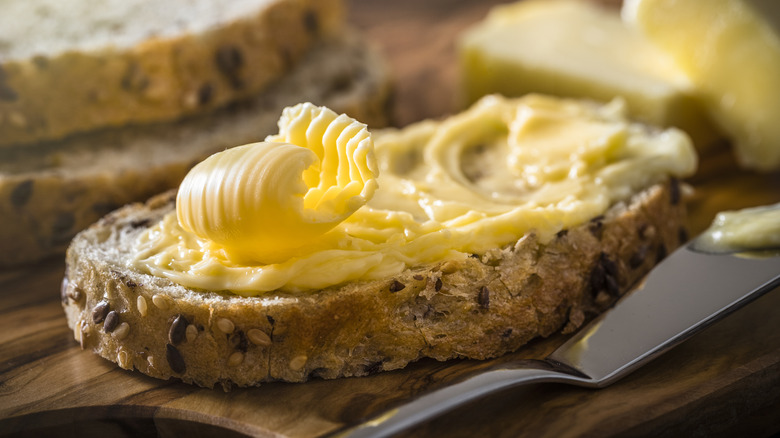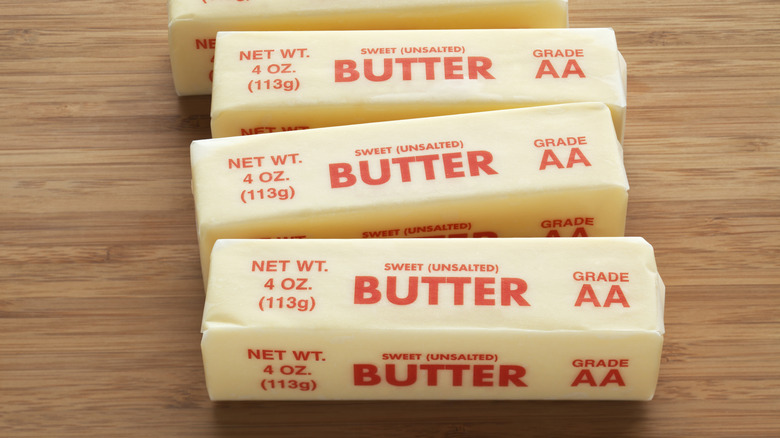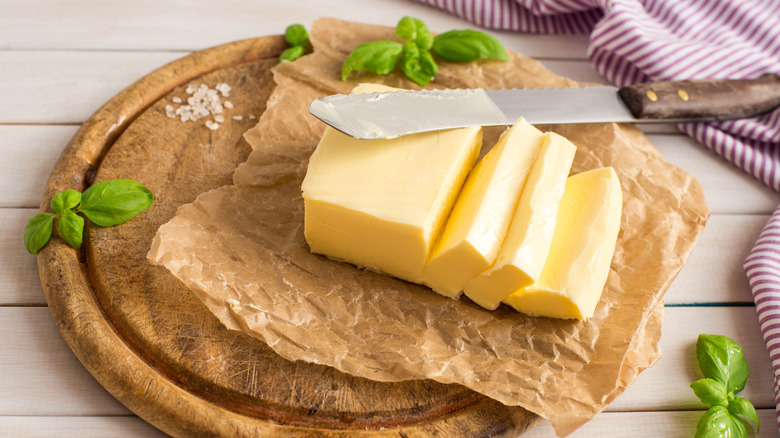There's Actually No Real Difference Between East And West Coast Butter
If you love to cook or bake, then you might be aware of the existence of "East Coast" and "West Coast" butter, as well as the supposed differences between them. If you grew up on the East Coast, you might have become accustomed to butter that typically comes in long, narrow sticks, usually in packs of four to six. On the West Coast, those regional sticks of butter are usually smaller and fatter than their East Coast cousins. Yet, although these two types of butter look different from each other, they are practically identical when it comes to ingredients and most always weigh 4 ounces — and you can use either for all of your cooking and baking needs.
Truthfully, the only reason there is a difference in packaging from coast to coast mainly comes down to a change in production in the early 1900s. Before that time, when butter was first produced in the United States, production facilities would usually issue them in standard large, 1-pound blocks. Over time, however, one company in the Midwest started to change things up due to a request from one of their buyers, and it changed the game forever.
The origins of East Coast butter
Before butter was mass-produced on a large scale, many stores sold the dairy product in large blocks wrapped in parchment paper that families would then be expected to cut up and store themselves. If they didn't buy it in a store, a lot of families would simply churn it on their own, as was common with rural households back in the day. However, in the early 1900s, things changed when some producers changed how it was done.
In 1906, a popular restaurant in New Orleans requested a modification to the large slab. They instead wanted their orders of butter be shipped in four, 4-ounce sticks, and the new shape eventually became a big hit.
So much so that the Elgin Butter Company in Elgin, Illinois, established by John Manley Adams in the 1870s and one of the biggest producers in the country, developed a special cutter to produce the desired long, narrow sticks. Since then, East Coast butter has also been referred to as Elgin sticks.
Why West Coast butter looks different
However, past the Rocky Mountains, this new trend for long, narrow butter sticks didn't take off as much as it did on the East Coast, and for a logical reason. When the Elgin Butter Company started using their proprietary cutter, the goods they sold were mainly to those who lived in the Midwest and east, while manufacturers on the West Coast didn't have access to the Elgin model to divide up their butter.
Eventually, producers on the West Coast became more prevalent in the 1960s and devised their own mold, which created short and stocky sticks that became known as "stubbies." Over time, as people moved from West Coast to East Coast or vice versa, a myth started to spread that there was a difference in the regional butter ingredients due to their difference in appearance.
Though, in actuality, there's nothing that makes these two types distinct besides their unique shapes. You can use both the same way when you want to soften butter or even want to make something like classic butter croissants. The only thing you may need to be mindful of is any kitchen tools you might use such as trays and dishes and making sure that your choice can fit the products you buy.



